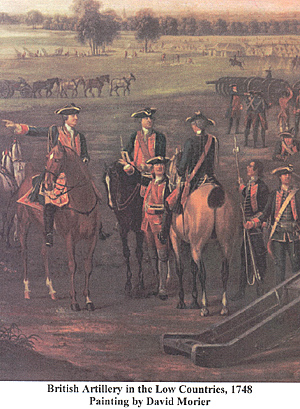 By the Seven Years' War, British artillery was well on the way to becoming an efficient and professional organization ready to stand alongside the other two arms as an equal. The stages on the way to this were its founding as a permanent body in 1716, its Royal status in 1722, the establishment of a regimental staff, the founding of the Royal Military academy at Woolwich in 1741, and the setting up of a cadet Company for trainee officers in 1744, where young gentlemen were subject to uniform military discipline after an unfortunate visit by Cumberland where they appeared as an unruly mob. This provided a trained officer corps, some of whom became celebrated for their exploits and who went on to command bodies of all arms later. However the Regiment was not completely integrated into the Crown's armed forces.
By the Seven Years' War, British artillery was well on the way to becoming an efficient and professional organization ready to stand alongside the other two arms as an equal. The stages on the way to this were its founding as a permanent body in 1716, its Royal status in 1722, the establishment of a regimental staff, the founding of the Royal Military academy at Woolwich in 1741, and the setting up of a cadet Company for trainee officers in 1744, where young gentlemen were subject to uniform military discipline after an unfortunate visit by Cumberland where they appeared as an unruly mob. This provided a trained officer corps, some of whom became celebrated for their exploits and who went on to command bodies of all arms later. However the Regiment was not completely integrated into the Crown's armed forces.
The Board of Ordnance was still largly responsible for it, and commissions came from the Master General of the Ordnance and not the King. While ranks were being aligned with those in the rest of the army, they were still distinct, reflecting the craft and technical nature of the work. Ranks at company level were: Captain-Lieutenant, Lieutenant, Second Lieutenant, Lieutenant Fire Worker, Cadet, Sergeant, Corporal, Bombardier, Cunner, Matross, , and Drummer. There was no purchase of commissions, so promotion was by seniority, which could be inefficient and slow. Much of the work expected of the men was highly skilled, as they manufactured the ammunition used in the guns in the laboratories set up whenever the army stayed in one place for a time. A great variety of ammunition was required, especially for siege warfare. The standard field guns used round shot and canister attached to their cartridges for efficient firing, but portfires, fuses, light shells, carcasses, and many other items were made, including, of course, fireworks for display. The material for these things was naturally highly dangerous.
The Artillery's performance in the War brought general praise and, apart from its essential role in battles and sieges all over the world, its intervention was often crucial, as at Minden in 1759.
The British Royal Regiment of Artillery
Back to Seven Years War Asso. Journal Vol. XII No. 3 Table of Contents
Back to Seven Years War Asso. Journal List of Issues
Back to Master Magazine List
© Copyright 2001 by James J. Mitchell
This article appears in MagWeb (Magazine Web) on the Internet World Wide Web.
Other articles from military history and related magazines are available at http://www.magweb.com